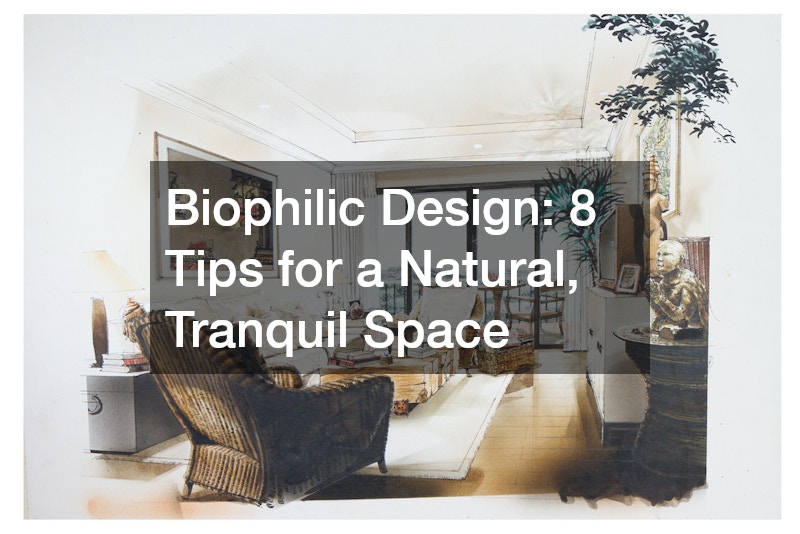In our fast-paced, modern world, people are looking for ways to connect with nature and create spaces that promote harmony and well-being. The biophilic approach is based on the belief that humans are innately connected to nature and thrive in natural environments. It integrates elements from nature into interior and architectural design. Researchers have found that being in nature can provide a number of benefits, including improved mood, reduced stress, and better cognitive function.
We can foster greater connection with nature by incorporating natural elements into our living space. This will promote mental and physical well-being and boost productivity. This comprehensive guide will cover the different aspects of biophilic designs and give you practical tips to transform your home into an oasis of tranquility inspired by nature.
1. Assess Your Space and Personal Needs
It’s important to assess your home before you dive into biophilic design. This first step will lay the foundation for a tailored design approach that aligns with your individual needs and preferences.
Look at the Layout
Start by examining your home’s size and layout. Assess the spatial dynamics in order to identify areas that are suitable for biophilic elements, such as natural lighting, greenery and ventilation. Custom home architects can provide invaluable insight into how to optimize your space for biophilic elements.
Analyze Natural Light Availability
Evaluate your home’s natural lighting. Think about the direction of your room and the location of the windows to maximize sunlight to create an inviting and bright atmosphere.
Explore Architectural Features
Note any architectural features which can be used to enhance biophilic designs. Consider integrating elements like large windows, skylights or outdoor living areas that encourage a closer connection to nature.
Consider Your Lifestyle
When planning your biophilic design, consider your daily routines and lifestyle habits. Consider how you use your home in different areas and look for opportunities to include biophilic elements that align with your daily activities and preferences.
2. Maximize Natural Light

Biophilic homes are characterized by natural light, which not only illuminates the living space but also helps us connect to the rhythms and cycles of nature. Explore a range of strategies to enhance your home’s ambiance and optimize lighting.
Increase Window Size and Placement
Start by strategically placing and maximizing windows in your home. Include custom glass elements from the floor to ceiling, or even covering entire walls to allow abundant light to flood your interior space. Consider installing picture or clerestory window that provide panoramic views of your surroundings. This will create a feeling of spaciousness and openness.
Utilize Reflective Surfaces
Incorporate reflective surfaces strategically into your design to enhance the impact of natural lighting. Integrate glass elements like mirrored panels and glass partitions to bounce sunlight around the room, amplifying it and creating dynamic light-shadow interplays. Mirrored surfaces or shiny finishes like polished metal can be used to diffuse natural light and give the interior a soft glow.
Minimize Sunlight Obstructions
Reduce obstructions to sunlight entering your home. Opt for window treatments that are easy to adjust, such as sheer curtains and blinds. This will allow you to control privacy and glare without blocking natural light. Consider removing walls or partitions that block the light and create open-concept spaces with seamless transitions from indoors to outdoors.
Install Skylights or Light Tubes
Skylights and light tubes can be used to provide daylight in interior spaces without direct windows. Install skylights over central gathering spaces such as kitchens or living rooms to create focal points for natural illumination. This will infuse these spaces with airiness and vitality. Light tubes can be discretely integrated into walls or ceilings to channel sunlight into dark areas of your home, reducing the need for artificial light during daylight hours.
3. Bring in Greenery and Plants
Plants are the most iconic biophilic symbol, bringing beauty and vitality to our interior spaces. Greenery and plants can improve air quality and reduce stress in your home. They also enhance cognitive function. Explore different ways to integrate plant life in your living space:
Diversify Your Plant Selection
Choose from a variety of plant species that are suited to the climate and lighting conditions in your home. This will ensure optimal growth and vitality. For low-light spaces, choose foliage plants like pothos, peace lilies, or snake plants. In areas with more sunlight, opt for succulents, herbs or flowering plants. Mix textures, colors, and growth patterns to add visual interest and depth to your home.
Strategic Placement for Maximum Impact
Plants can have a positive impact on your health and aesthetics. Arrange potted planters on countertops, windowsills and shelves to add a touch of greenery. This will also create focal points. Hanging planters and macrame plant holders can be used to maximize vertical space while adding dimension to your décor. Consider the idea of “biophilic zoned” where plants are grouped in certain areas to simulate natural ecosystems. This will promote a connection with nature.
Maximize Greenery in Small Spaces
Vertical gardens, living walls, or terrariums are innovative ways to maximize greenery in smaller spaces. Installing modular planters and trellises on walls or partitions will create lush green backdrops. Consider hydroponic and aeroponic gardening methods, which are easy to maintain while producing abundant fresh herbs or greens.
Enhance Outdoor Spaces With Greenery
Transform your outdoor areas into lush retreats to evoke tranquility and a connection with nature. Work with a landscape contractor to create lush garden landscaping that features native plants and flowering bushes that thrive in your climate. Shade trees are strategically planted for cooling shade, shelter from the weather and to create comfortable outdoor spaces. Tree services can help you select and plant species that are known for their dense foliage and broad canopy, like oak, maple, or beech. You will get the most out of your natural shade while also adding seasonal interest and visual interest to your landscape.
4. Opt for Natural Materials
Biophilic design is based on the use of natural materials such as wood, stone, and earth to create spaces that radiate warmth, comfort, and a deep connection with the outdoors. Choose materials that are sustainably sourced to enhance your home’s aesthetics and environmental consciousness. These materials minimize the ecological impact of their production while celebrating nature’s inherent beauty.
Choose Sustainable Materials
Explore a wide range of sustainable materials which resonate with biophilic design. Hardwood flooring from responsibly managed forests will infuse the warmth and character of your interiors. Choose from a wide range of wood species, finishes and plank sizes to create a timeless and durable foundation for your home.
Incorporate Natural Textures and Finishes
Materials with textures and finishes which pay homage to diverse landscapes and natural elements are ideal. Reclaimed wood accents such as salvaged timber or barnwood beams can add rustic character and charm to your interiors. Choose locally sourced natural stone countertops to give your kitchen and bathroom the rugged beauty of granite, quartzite, or marble.
Consider the natural beauty of wood plantation shutters made from sustainable woods like bamboo or basswood. Consider the earthy beauty of clay plaster walls. They are a great alternative to traditional drywall and offer an environmentally friendly and breathable option.
5. Embrace Organic Shapes and Patterns
Biophilic design is based on the incorporation of organic shapes and patterns found in nature. This gives spaces a feeling of fluidity, vitality, and dynamism. Integrating these elements into architectural details and furnishings can help you create environments that inspire harmony and balance while cultivating a deep connection with the natural world.
Introduce Fluid Forms
Furniture with soft curves and edges will reflect the natural contours of landscapes. Consider pieces made from wood or rattan that complement organic shapes while enhancing the tactile experience in your living space. Prioritize designs that encourage relaxation and movement in the room, from sinuous sofas to sculptured coffee tables.
Incorporate Natural Motifs and Textures
Rugs, textiles and accessories that are inspired by nature’s wonders can be used to infuse your home with natural textures and motifs. Patterns reminiscent of flowing water, leaves or flowers will add visual interest to your space and give it a vibrant feel. Choose materials such as wool, cotton or jute to evoke warmth and comfort. This will create a sensory-rich space that will envelop you in tactile delight.
Explore Biomimicry
Consider using biomimicry, the imitation of natural systems and processes, to inform your design decisions and create spaces that resonate with our connection to nature. Consider integrating innovative technologies and materials inspired by nature, such as biophilic light systems that mimic dappled sunlight filtering through tree canopies or acoustic panels designed to replicate the sound-absorbing qualities of natural foliage.
6. Create Views of Nature
Views of the natural world have a profound effect on our well-being. They promote relaxation and reduce stress. For biophilic design to work, it is important to create views of nature in order for people to feel a stronger connection with the natural world.
Frame Natural Vistas
Arrange furniture strategically to frame windows or outdoor views, bringing attention to the beauty of the landscape. Include seating areas with panoramic views of gardens or forests. Water features can also be included. This will encourage moments of reflection and relaxation. You can create a more natural connection with your space by carefully positioning elements.
Use Reflective Surfaces for Extended Views
Place mirrors strategically to enhance natural light in your home and expand views of the outdoors. Mirrors placed opposite glass doors or windows will reflect the outdoor scenery and double your visual impact. This will create a feeling of depth and spaciousness in your home. Mirrors’ reflective qualities can enhance the beauty of nature, and give your home a bright and airy feel.
7. Improve Indoor Air Quality

Indoor air quality has a direct impact on our health and well-being. Here are some ways to improve the air quality in your house:
Promote Natural Ventilation
Integrate natural ventilation to encourage airflow and circulation in your home. Use louvers or skylights that can be opened to allow fresh air from outside in, helping to flush out pollutants and restore oxygen levels. By strategically locating windows and doors, you can harness the prevailing breezes to create cooling airflow patterns in your home.
Use Air-Purifying Plants
Integrate air-purifying plants in your interior space to improve the quality of indoor air. Distribute strategically around your home plant species that are known to have air-purifying qualities, such as peace lilies and spider plants. These botanical allies will not only purify your home but also add oxygen and moisture to it, creating a more vibrant and healthy indoor environment.
Install High-Efficiency Air Filtration
Air filtration systems with high efficiency can remove allergens and airborne contaminants from the indoor air of your home. These systems use advanced filtration technology to capture pollen and other pollutants. This ensures that your indoor air is clean and fresh all year round. You can rest easy by investing in the latest filtration technologies.
Select Low-VOC Materials
Low-VOC paints and finishes are the best way to reduce indoor air pollution and create a healthy indoor environment. Choose eco-friendly finishes and materials that emit minimal volatile compounds to reduce the risk of allergic reactions and respiratory irritation. Natural materials, such as organic textiles, wool carpets, and solid wood furniture, will improve the indoor air quality and add warmth to your home.
8. Add Water Features for a Calming Atmosphere
Water is a valuable component in biophilic designs because it has a calming, rejuvenating effect on the senses. Water features can help you create a deeper connection with nature while also enhancing your living space.
Design Serene Water Spaces
Integrating biophilic elements into your home can transform it into a tranquil retreat. They evoke relaxation and tranquility. Consider adding a biophilic swimming pool to your outdoor area. Pool services can help you create a naturalistic paradise that blends seamlessly with the landscape. Create a relaxing atmosphere by surrounding the pool with native plants and lush greenery. This will enhance the connection to the natural world. Include features such as rock formations or waterfalls to create the illusion of natural water bodies. This will provide soothing sounds and sights.
Enhance Soundscapes With Water Elements
Installing a tabletop water feature in your living area or a small garden pond will add visual and auditory interest to the space. Choose a wall-mounted water feature to create a focal point in your entranceway that will welcome guests with the soft murmur of flowing waters. These water features are not only a great way to enhance your sensory experience, but they also anchor the design scheme of any room and create a feeling of well-being. Some plumbers have a specialization in installing and maintaining water features. This ensures that the additions blend seamlessly into your space and operate efficiently.
Final Thoughts
The biophilic approach is a holistic way to create living spaces that encourage health, well-being, and a connection with nature. We can nourish our minds, bodies, and spirits by incorporating natural elements like natural light, plants and greenery, natural materials, and water features. If you are renovating or building a home, biophilic principles can help create a tranquil sanctuary inspired by nature.
